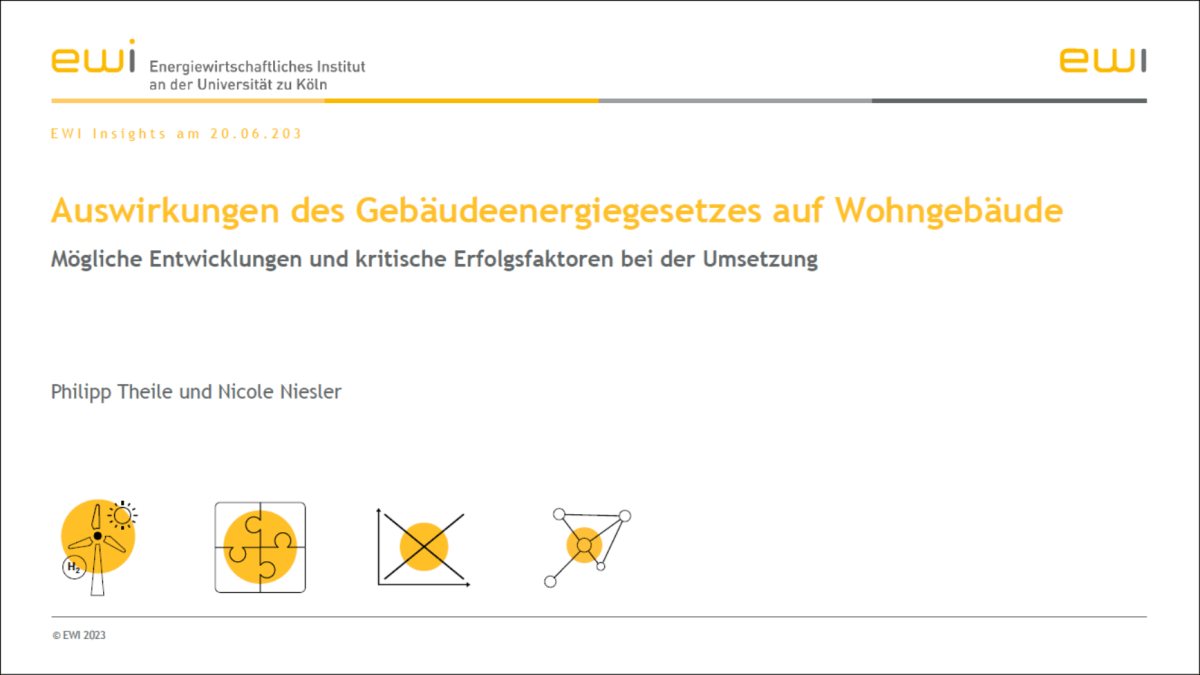
Researchers from the Institute of Energy Economics at the University of Cologne (EWI) presented results of a recent analysis on the impact of the Building Energy Act (BEA) on residential buildings and critical success factors for the implementation of the BEA as part of the EWI Insights webinar series. The event was moderated by Max Gierkink, Manager at EWI.
EWI’s online workshop series has been held about four times per year since 2020 and is aimed at professionals from business, academia, and politics who are interested in scientific research on the energy world. EWI researchers offer insights into current studies and analyses of the institute.
Philipp Theile, Senior Research Associate at EWI, presented during the first part three scenarios regarding the development of the building sector until 2030. These are based on the cabinet´s adopted draft to the BEA dated April 19, 2023. The analysis includes the stock of heating systems, the refurbishment rate and GHG emissions from the residential building sector. The amendment of the BEA aims to help achieve climate targets in the building sector and reduce dependence on fossil fuels. “In all considered scenarios, the share of heat pumps increases strongly, and the importance of heat grids rises,” Theile said.
In the first scenario, network operators provide additional guarantees for future hydrogen supply to new gas-fired heating systems. The second scenario sees more residential buildings connected to existing heating grids on the one hand, and a growing number of new heating grids built on the other. Under the third scenario, guarantees for hydrogen supply are only provided in exceptional cases and primarily existing heat grids are densified, so that heat pumps are in many cases the central fulfillment option. In the scenarios considered, the number of heat pumps increases from 1.0 million in 2020 up to 6.3 million in 2030. The number of heat grid connections could increase from 1.3 million to 2.2 million as new heat grids are built beyond densification projects. Meanwhile, the number of oil- and gas-fired heating systems could drop by 30 percent. Consequently, achieving the sectoral climate targets of the buildings sector would be possible based on the cabinet´s adopted draft of the BEA.
However, it is becoming apparent that the final amendment of the BEA will differ from the cabinet’s draft of April 19, 2023. According to the Guidelines of the Government Parties of June 13, 2023, the BEA´s requirements for existing buildings will not apply until municipal heat planning has been completed. The time horizons envisaged for completion are by the end of 2026 (municipalities >100,000 inhabitants) and by the end of 2028 (municipalities > 10,000 inhabitants). Furthermore, legacy heating systems are expected not to be limited in their lifespan. If so, in 2030 more oil and gas heating systems would be in use than the scenarios assume.
In the second part of this event, Nicole Niesler, Senior Research Associate at EWI, presented critical success factors for the implementation of the heat transition. The scenario developments cannot reflect all critical success factors involved in implementation and for example would require additional capacities of craftsmen, higher investments by households, and accelerated planning and implementation of new heat grid projects.
“Increasing refurbishment activities and installments of heat pumps are increasing the demand for craftsmen. Current projections indicate stagnant capacity through 2030, which could lead to higher costs and longer waiting times,” Niesler says. The timeline of municipal heat planning could also complicate implementation. Guarantees for future heat grid connections and hydrogen supply would be required as early as 2024, according to the proposed BEA-draft bill. The prerequisite for these guarantees is the municipal heat plans, which, according to the status of the ministerial draft bill on municipal heat planning, will not be available until the end of 2026 or 2028.
The Guidelines of the Government Parties of June 13, 2023, address this temporal conflict, but at the expense of delaying implementation of the BEA regulations. In addition, a general adjustment of the guarantee periods from the BEA draft implies new gas heating systems to be installed even in areas which are unattractive for future heat grid connections or hydrogen supply.